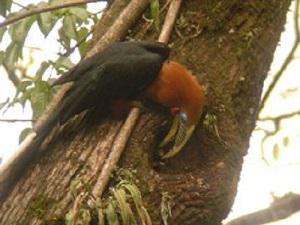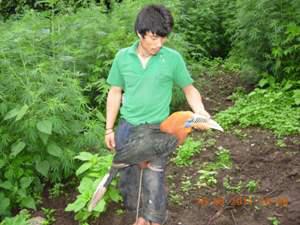Rinchen Drakpa
The project aims to determine critical habitat requirement and home range size of Rufous-necked Hornbill in the sub-tropical broadleaved forest of Thrumshingla National park, Bhutan.

RNH(M) feeding female.
The Rufous-necked Hornbill Aceros nipalensis is critically threatened species, categorized as vulnerable species. It has thought to be extinct in Nepal and has disappeared from many areas in Thailand. Its population has declined dramatically and is now very rare across much of its historical range (IUCN 2009). In Bhutan Rufous-necked Hornbill is listed in protected species under the schedule I of the Forest and Nature Conservation Act of Bhutan, 1995. One of the mandates of Thrumshingla National Park is to conserve such critically endangered species. Numerous Rapid Biodiversity Assessments in the Park was conducted. This has featured that a detail study of Rufous-necked Hornbill to ensure the better understanding of critical habitat requirements and home range is crucial. Thus, Movement and habitat use study of Rufous-necked Hornbill will be conducted in the sub-tropical broadleaved forest of Thrumshingla National Park through radio telemetry to understand critical habitat requirement and home range size.

Captured male bird, radio tagged.
This detailed study has never been conducted in Thrumshingla National Park or in any other part of Bhutan. We know that Rufous-necked Hornbill is present in Bhutan but documentation about the species status is not yet adequately documented to prevent extinction of the species. Two birds will be tagged using radio telemetry. Data will be collected on seasonal basis. A plot size of 10mX10m will be laid to collect habitat use and diet species data wherever telemetry locations of bird are detected home range data analysis will be done with Colhome range software. Spatial data will be analysed with Arch View GIS 3.3. Habitat use data analysis is to be done with excel spread sheet.
This action-oriented research will map the home range size, critical habitat requirement, zonation of the park areas and design the management interventions to ensure the conservation of Rufous-necked Hornbill in Bhutan. At the end of the study, it is expected to meet following outcomes:
1. Map home range size and critical habitat requirements of Rufous-necked Hornbill.
2. Draw management interventions to ensure habitat for harbouring Rufous-necked Hornbill.
3. Expected to help in proper zonation of park areas.
The study has been planned to commence from July 2010 and end in October 2011